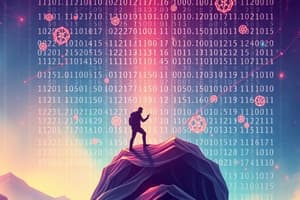Podcast
Questions and Answers
Which of the following is NOT a type of computer encoding system?
Which of the following is NOT a type of computer encoding system?
- EBCDIC
- Unicode
- ASCII
- HTML (correct)
What does ASCII stand for?
What does ASCII stand for?
American Standard Code for Information Interchange
Binary numbers consist of only zeros and ones.
Binary numbers consist of only zeros and ones.
True (A)
What type of characters can the original 7-bit ASCII code represent?
What type of characters can the original 7-bit ASCII code represent?
By late ___, computers started to communicate with each other.
By late ___, computers started to communicate with each other.
Which encoding system has been extended to 8-bit to represent 256 characters?
Which encoding system has been extended to 8-bit to represent 256 characters?
EBCDIC is a character encoding scheme that uses 7 bits.
EBCDIC is a character encoding scheme that uses 7 bits.
What are the two types of data that a computer understands?
What are the two types of data that a computer understands?
What is the purpose of the 8th bit in the 7-bit ASCII code?
What is the purpose of the 8th bit in the 7-bit ASCII code?
The extended ASCII character set represents characters in the range of ___ to 255.
The extended ASCII character set represents characters in the range of ___ to 255.
Flashcards are hidden until you start studying
Study Notes
Chapter Objectives
- Learn about five common types of computer encoding systems.
- Differentiate characteristics of each encoding system.
- Convert between BCD and Binary Number.
- Convert from Gray Code to Binary Number.
Introduction
- Computers assist in complex tasks like calculations and report generation.
- Handle textual data including alphabets, digits, special symbols, and non-printable characters.
- Binary number system (0s and 1s) is the fundamental language of computers.
Binary and Data Representation
- Computers use transistors as on/off switches, storing data as binary at a fundamental level.
- Data transmission utilizes magnetic properties to represent binary digits in storage.
- All digital data, whether numerical or textual, must be ultimately represented in binary.
Need for Standardized Encoding
- With the rise of interconnected computers in the late 1950s, standard representation of textual data became crucial for compatibility.
- Development of encoding systems allowed different computers to transmit data effectively.
Types of Computer Encoding System
- Five encoding systems include:
- ASCII (American Standard Code for Information Interchange)
- Unicode
- EBCDIC (Extended Binary Coded Decimal Interchange Code)
- BCD (Binary-Coded Decimal)
- Gray Code
ASCII Encoding
- Developed in the 1960s by ANSI, originating from telegraphic codes.
- Most common coding scheme for personal computers, excluding IBM Mainframes.
- Initially a 7-bit code, allowing representation of 128 characters.
ASCII Character Representation
- Extended to an 8-bit code for improved memory organization, capable of representing 256 characters.
- The 8th bit is utilized for parity checking to ensure accurate data transmission.
- ASCII character divisions:
- 0 – 31: Control characters.
- 32 – 127: Standard alphanumeric characters.
- 128 – 255: Special symbols and non-standard (extended) characters.
Unicode
- Developed to address global digital communication needs beyond English-speaking countries.
- Supports a vast array of characters from diverse languages and scripts, accommodating a multicultural digital environment.
Studying That Suits You
Use AI to generate personalized quizzes and flashcards to suit your learning preferences.




